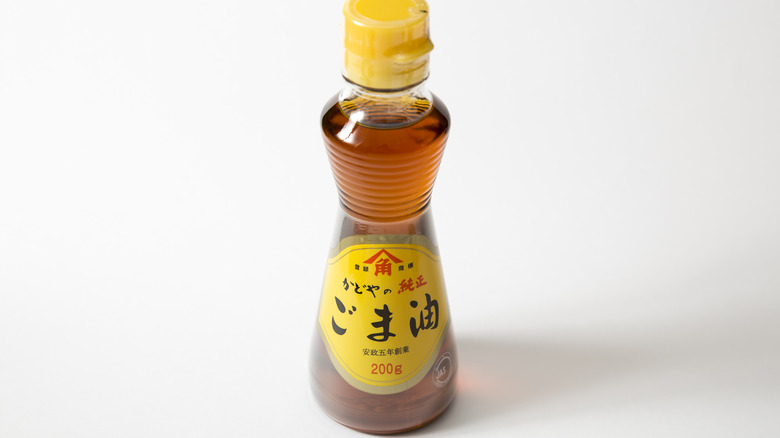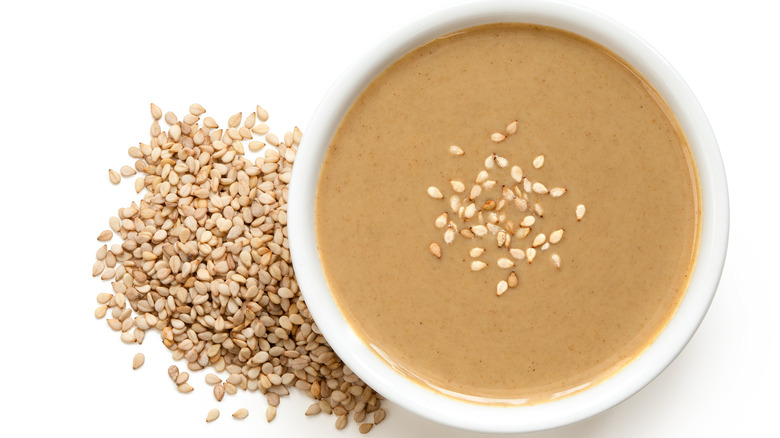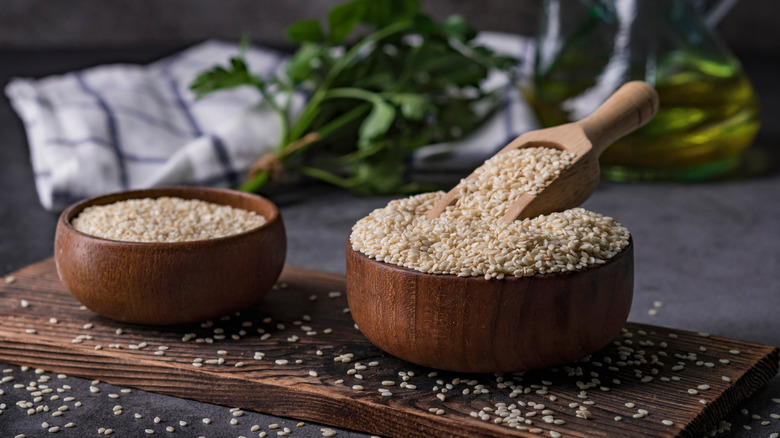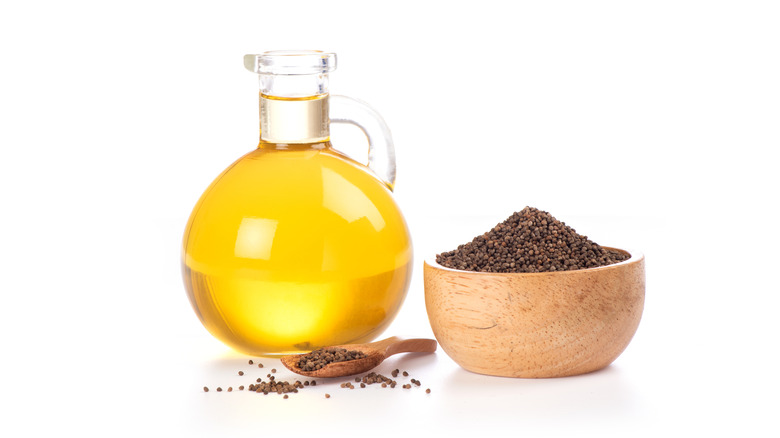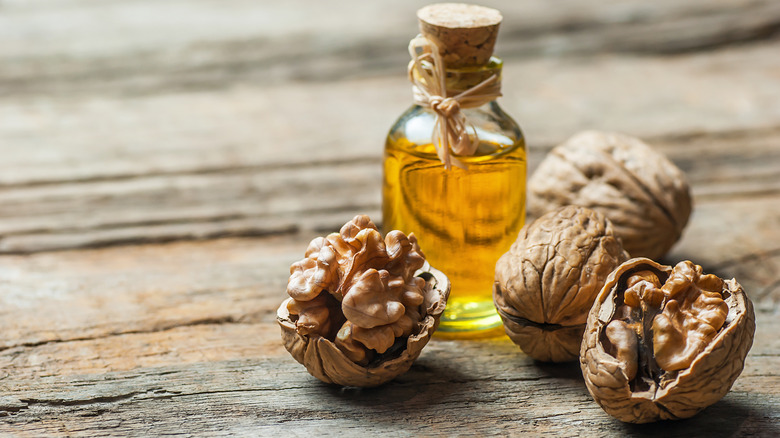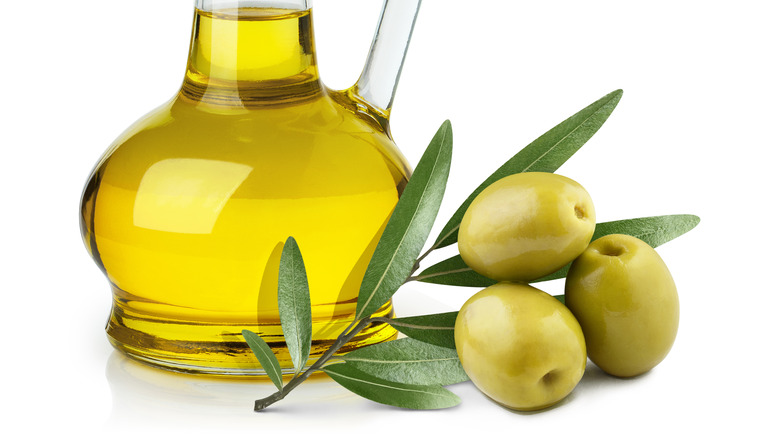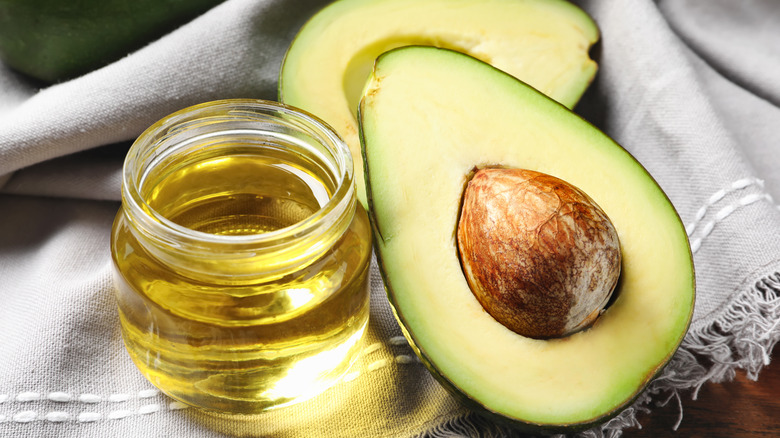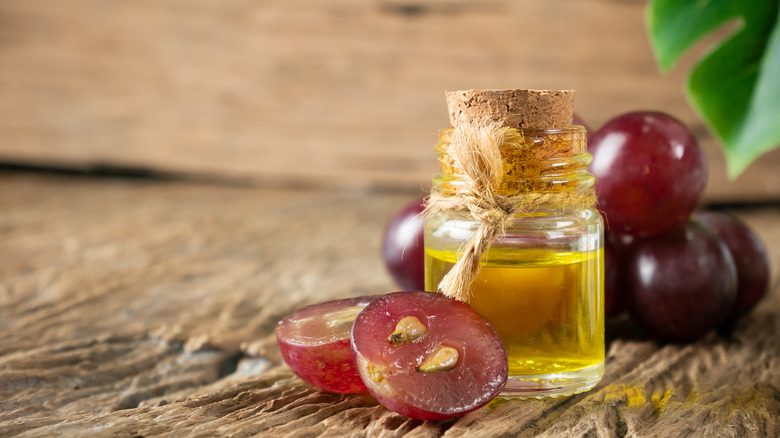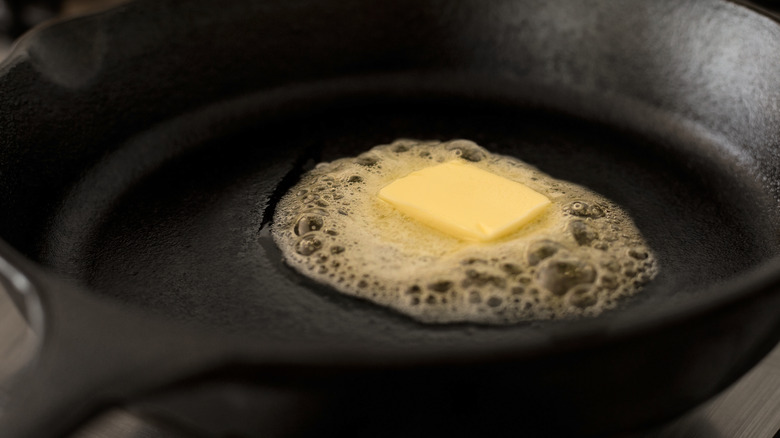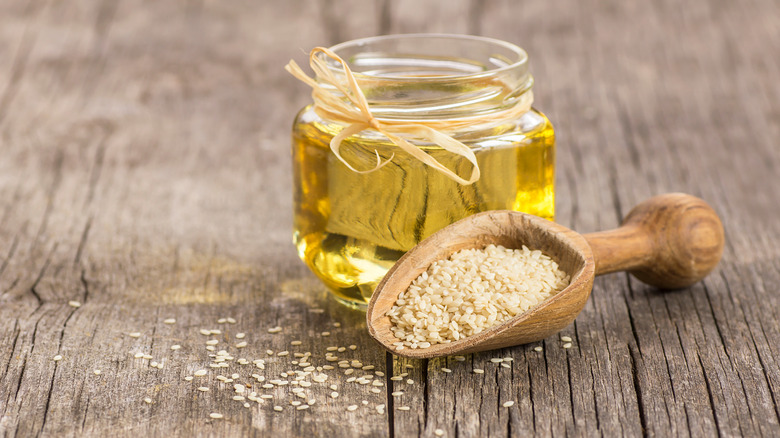10 Best Substitutes For Sesame Oil
While many pantries will contain a bottle of neutral oil like canola oil or a classic like olive oil, chances are unless you're a fan of Asian cuisine, you may not have sesame oil on hand at all times. However, it can be a crucial addition to many tasty dishes — although there are a few things to be aware of if you're considering substitutions.
First of all, know that there are two distinct types of sesame oil. The first, often referred to simply as regular sesame oil, is crafted by pressing raw sesame seeds (via Martha Stewart). It's lighter in color, has a much more neutral flavor, and has a high smoke point. This type of sesame oil is ideal for anywhere you'd use another neutral oil, such as when you're roasting or frying something.
Toasted sesame oil is an entirely different matter. As the name suggests, it's made by toasting the sesame seeds prior to pressing them, in order to bring out all those nutty, toasty flavors (via The Spruce Eats). It's a much darker hue, and it's not what you want to use for frying. Instead, use it as a finishing oil or as you would use a condiment for some extra flavor, drizzling it sparingly over dishes or incorporating it in sauces where the flavor can shine.
Once you determine whether your recipe calls for regular sesame oil or toasted sesame oil, you'll be on your way to figuring out the ideal substitute.
1. Tahini
If you're trying to find a substitute toasted sesame oil that will replace that signature flavor, tahini can be an ideal option because, well, it contains much of the same toasty, nutty flavor notes (via The Kitchen Community). It's crafted from sesame seeds, and will give your dish a similar flavor profile.
Tahini is already an absolute superstar in dressings and sauces, and would be ideal in dishes where the toasted sesame seed oil is a finishing flavor component, such as drizzled atop a stir fry or incorporated in a sauce. The only thing you'll really need to be wary of is the consistency. Tahini is a thick paste, and especially if the dish is cold, you'll likely need to add some type of liquid to achieve the consistency you're looking for. If you want to keep the balance of flavors, add a bit of water to thin the tahini out (via WikiHow). Alternatively, you could add a bit of oil such as olive oil or grapeseed oil, or even use a squeeze of lemon juice, which incorporate a hint of acidity while also thinning out the tahini.
For best results, substitute an equal amount of tahini for the toasted sesame oil in your recipe, and simply thin it out a bit for your recipe.
2. Toasted Sesame Seeds
If all you want in your recipe is that sesame flavor and texture isn't critical, you may find it best to simply swap out the toasted sesame oil in your recipe with actual toasted sesame seeds. After all, they're what give toasted sesame oil it's delectable flavor. All you need to do is take some raw sesame seeds and toast them in a skillet until they're slightly brown and fragrant, as you would do for other spices and nuts (via Better Homes and Gardens). They can then be sprinkled over your dish to add that extra burst of flavor.
Note that this substitution works best in dishes where you just need that nutty sesame flavor, such as sprinkled on top of grain bowls or salads, or incorporated as an extra flavor in baked goods. It won't work as well in dishes where you need the oil to create a silky smooth sauce, for example, or where you need oil to bind together other ingredients.
Toasted sesame seeds can have quite a strong flavor, so for best results, you'll want to taste as you go and err on the side of caution (via New Idea). For example, if your recipe calls for 2 tablespoons of toasted sesame oil, add in a tablespoon of toasted sesame seeds, then increase the amount if the flavor isn't strong enough.
3. Perilla Oil
Perilla oil, crafted from pressing and extracting oil from the perilla plant, has many similarities to toasted sesame oil in terms of flavor as well as texture, making it an ideal substitute, per Robust Kitchen. It's a staple in Asian cuisine, and is found in many Korean dishes in particular. Perilla oil is most often seen in dips and sauces, used more as a finishing oil or condiment, just as toasted sesame oil is.
There are just a few downsides to consider with this particular substitution. First, while perilla oil has many health benefits, including anti-inflammatory properties, The Kitchen Community notes it also contains a lot of allergens and may not be suitable for pregnant people, which is something to consider depending on who you're cooking for. It can also be a bit difficult to find in regular supermarkets, so while you may have it on hand if you love to cook Asian dishes, it isn't as easily accessible as some other substitutes.
Given the similarities in both taste and consistency, for best results you'll want to swap out toasted sesame seed oil in your recipe with an equal amount of perilla oil.
4. Peanut Oil
One of the distinct flavor notes in toasted sesame oil is nuttiness, which is why peanut oil can be a great substitute if you're looking to capture that nutty flavor and aroma. Like sesame seeds, peanuts will also impart a bit of richness, adding to the complexity of flavors in your dish, although the flavor isn't as bold as toasted sesame oil (via New Idea). Peanut oil also has a very high smoke point, just as regular sesame oil does, so it can be the ideal substitute for a dish that may involve some heat in the preparation, such as a stir fry that involves a bit of regular sesame oil to sautee the ingredients, and some toasted sesame oil to finish it off.
Peanut oil can be an ideal swap for those who have a sesame allergy, but obviously isn't an appropriate substitute for anyone with a nut allergy. As an added bonus, peanut oil packs a few appealing health benefits, including anti-inflammatory properties, and can reduce the risk of heart disease (via The Kitchen Community).
For best results, you'll want to use the same amount of peanut oil as you would have used sesame oil in your recipe, given how similar they are.
5. Walnut Oil
Another nutty substitute for sesame oil, walnut oil is an ingredient that you may have kicking around your pantry if you love to experiment with different flavors in your dressings and sauces. As one might expect given that it's crafted from pressed walnuts, The Spruce Eats explains walnut oil has a delectable nuttiness to it, as well as a hint of sweetness and a lot of richness. It is also packed with omega-3 fatty acids. While it can be pricier than other substitutions, you likely won't need to use a large amount of walnut oil, as it's better used on cold dishes or as a finishing oil.
One thing to be aware of is that walnut oil has a very low smoke point of about 350 degrees Fahrenheit (via Robust Kitchen). This means you don't want to use it for recipes that require high heat levels, or the oil will turn a bit bitter and potentially ruin the dish.
For best results, you'll want to add just a bit less walnut oil than you would add sesame oil, around ¾ the amount. So, in a recipe where you may include 1 tablespoon of sesame oil, you'll swap in ¾ tablespoon of walnut oil instead.
6. Olive Oil
Olive oil is extremely commonly used, and there's a high likelihood that you already have a bottle in your pantry, and if not, you'll be able to easily find it at any grocery store. The accessibility of this makes it a simple substitute. However, olive oil doesn't have a ton of flavor on its own, so this is a better substitution for dishes that require regular sesame oil, not toasted sesame oil. The area where olive oil shines is high heat cooking — it's a great substitute for recipes that call for sesame oil in order to fry something (via New Idea). The neutral taste means it won't add a lot of flavor to your dish, allowing all the other flavors to really shine while the oil simply adds a little lubrication to the cooking process.
You'll just want to be careful that you're not accidentally using extra virgin olive oil — while it has many benefits and can add depth of flavor to dressings and sauces, The Kitchen Community notes it has a very different flavor profile than either toasted or regular sesame oil and will likely change your dish.
For best results, you can use the same amount of olive oil as you would regular sesame oil.
7. Avocado Oil
If you're using regular sesame oil for the purposes of searing, broiling, or stir frying, avocado oil just might be the ideal substitute thanks to its high smoke point (via Robust Kitchen). This makes it perfect for recipes where you need the high smoke point of sesame oil, but the flavor isn't as much of a concern, as avocado oil is relatively flavorless. When cold, avocado oil has a slightly herbal flavor, but nothing so strong that you'd really be able to detect it in a dish; when heated, it's nearly flavorless.
Additionally, this particular oil has some health benefits, as it is rich in omega 9 as well as vitamin E according to The Kitchen Community, adding a little extra dose of nutrients to whatever you're using it for.
For best results, given the similarity in consistency and the mild flavor, you can simply use the same amount of avocado oil as you would sesame oil.
8. Grapeseed Oil
If your recipe contains regular sesame oil used for the purpose of high-heat cooking, grapeseed oil can be a fantastic alternative because it is virtually invisible in a dish (via The Kitchen Community). It is completely flavorless, which isn't ideal if you want the oil to be a featured component in your recipe, but is perfect for situations where you just need an oil to withstand high heat and allow your other ingredients to shine.
Grapeseed oil also has a few health benefits, such as antioxidant and anti-inflammatory properties, per The Kitchen Community. The one thing in particular to be aware of when working with grapeseed oil is that, compared to other oils, it has a relatively short life span. So, if you've had a bottle of grapeseed oil hanging out in your pantry for as long as you can remember, give it a good sniff to ensure it hasn't gone rancid before you add it to your dish. The neutral oil is relatively common, and can be found in most grocery stores.
For best results, simply swap in the same amount of grapeseed oil as you would have used regular sesame oil.
9. Brown Butter
Anyone who has ever gone to the trouble of heating butter in a pan until it's frothy and deliciously fragrant, eventually turning a warm shade of caramel, knows just how delectable brown butter is. It can take any dish to the next level — so why not consider using it as a substitute for sesame oil? Butter always adds a richness to any dish you use it in, but after being browned, it also contributes a hint of sweetness and nuttiness, which is perfect if you're looking to swap it out for toasted sesame oil (via The Kitchn).
Brown butter is particularly well suited for baking, but could also be used as a finishing condiment for that decadent flair. As far as ingredients go, butter is very easily found just about anywhere, even at small grocery stores with very limited selections. Plus, depending on the amount your recipe needs, you'll have some of this versatile ingredient left over for any other dishes you want to whip up!
For best results, once you've browned your butter, use the same amount as the recipe calls for sesame oil.
10. DIY Sesame Oil
Perhaps you're not the type of cook who likes to make substitutions, or perhaps your recipe is very particular and you worry that deviating from it in any way will prevent the dish from turning out the way it's supposed to. Not to worry — if you're willing to go to a bit of extra effort, you can actually make your own homemade sesame oil that is very, very similar to toasted sesame oil. All you need is sesame seeds that have been toasted and some type of neutral, relatively flavorless cooking oil, such as olive oil or grapeseed oil.
The steps are relatively simple and only take a few minutes. You'll want to combine about ¼ cup of sesame seeds and one cup of a neutral oil in a pot and heat over medium for about five minutes, until the seeds begin to brown and the oil develops those toasted, nutty aromas (via Robust Kitchen). After it cools, blend the mixture, New Idea instructs, and let it continue infusing for about two additional hours. Depending on your preferred texture, you can leave the mixture as is, or strain out the seeds using a cheesecloth.
As a reward for your efforts, you'll have a virtually identical substitute for toasted sesame oil that you can use in any recipe. It requires a bit more work than simply grabbing an alternative bottle of oil, but the flavor similarities can't be beat.
